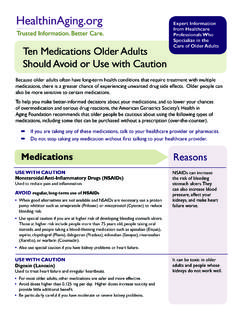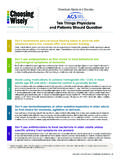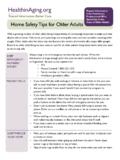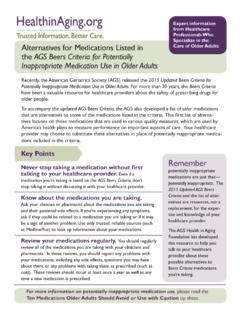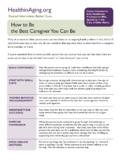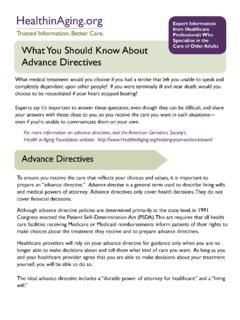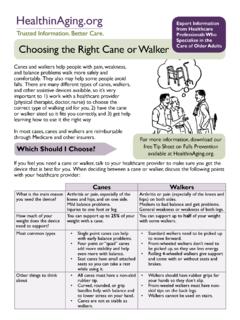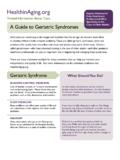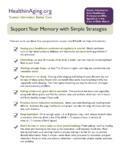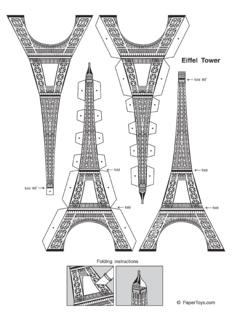Transcription of Winter Safety Tips for Older Adults - Health in Aging
1 Winter Safety tips for Older AdultsBaby, It s Cold Outside! When the temperature drops, Older Adults run a higher risk of Health problems and injuries related to the weather, including hypothermia, frostbite, and falls in ice and snow. Like most things in life, it is better to be prepared. Here are a few precautions everyone should take, especially Older Adults , this time of Information from Healthcare Professionals Who Specialize in the Care of Older AdultsPrecautions to TakeHYPOTHERMIAH ypothermia occurs when your body temperature drops to a dangerous level. Your body temperature can drop when you are out in the cold for an extended time because it begins to lose heat quickly. Older Adults are at an increased risk of hypothermia due to changes that happen to your body with Aging . Warning Signs Cold skin that is pale or ashy Feeling very tired, confused and sleepy Feeling weak Problems walking Slowed breathing or heart rate Shivering is not a reliable warning sign because Older people tend to shiver less or not at all when their body temperature dropsCondition and Warning Signs Stay indoors (or don t stay outside for very long).
2 Keep indoor temperature at 65 degrees or warmer. Stay dry because wet clothing chills your body more quickly. Dress Smart protect your lungs from cold air. Layer up! Wearing 2 or 3 thinner layers of loose-fitting clothing is warmer than a single layer of thick clothing. Think about getting your thermals! Essential Winter wears: hats, gloves or preferably mittens, Winter coat, boots, and a scarf to cover your mouth and 911 if you think you or someone else is experiencing Frostbite occurs when your body experiences damage to the skin that can go all the way down to the bone. Not surprisingly, extreme cold can cause frostbite. It is most likely to occur on body parts farthest away from your heart. Common places include your nose, ears, cheeks, chin, fingers and toes. In severe cases, frostbite can result in loss of limbs. People with heart disease and other circulation problems are at a higher risk.
3 Warning Signs Skin that s white or ashy or grayish-yellow Skin feels hard or waxy Numbness Cover up! All parts of your body should be covered when you go out in the cold. If skin turns red or dark or starts hurting, get inside right frostbite has happened: run the affected area under warm (not hot) water. Call for medical help if you think you or someone else has to TakeCondition and Warning SignsFALLS It is easy to slip and fall in the Winter , especially in icy and snowy conditions. Make sure steps and walkways are clear before you walk. Be especially careful if you see wet pavements that could be iced over. Clear away snow and salt your walkways at home, or hire someone to do it. Wear boots with non-skid soles this will prevent you from slipping. If you use a cane, replace the rubber tip before it is worn smooth. Consider an ice pick-like attachment that fits onto the end of the cane for additional WHILE SHOVELING SNOW It s one of the evils of Winter snow shoveling.
4 Just make sure that if you choose to shovel, you take some precautions. Remember, when it s cold outside, your heart works double time to keep you warm. Strenuous activities like shoveling snow may put too much strain on your heart, especially if you have heart disease. Shoveling can also be dangerous if you have problems with balance or have thin bones (osteoporosis). Ask your healthcare provider whether shoveling or other work in the snow is safe for AND CARBON MONOXIDE POISONING During the Winter months, it is common to use the fireplace or other heating sources, such as natural gas, kerosene and other fuels. Unless fireplaces, wood and gas stoves and gas appliances are properly vented, cleaned, and used, they can leak dangerous amounts of carbon monoxide a deadly gas that you cannot see or smell. These and other appliances, such as space heaters, can also be fire Signs Headache Weakness Nausea or vomiting Dizziness Confusion Blurred vision Loss of consciousness Call an inspector to have your chimneys and flues inspected preferred annually.
5 Open a window (when using a kerosene stove) just a crack will do. Place smoke detectors and battery-operated carbon monoxide detectors in strategic places especially in areas where you use fireplaces, wood stoves, or kerosene heaters. Make sure space heaters are at least 3 feet away from anything that might catch fire, such as curtains, bedding and furniture. Never try to heat your home using a gas stove, charcoal grill, or other stove not made for home there is a fire, don t try to put it out. Leave the house and call you think you may have carbon monoxide poisoning, get into fresh air and get medical care immediately. Precautions to TakeDISCLAIMER: This information is not intended to diagnose Health problems or to take the place of medical advice or care you receive from your physician or other healthcare provider. Always consult your healthcare provider about your medications, symptoms, and Health problems.
6 December 2015 Condition and Warning Signs 2015 Health in Aging Foundation. All rights reserved. This material may not be reproduced, displayed, modified, or distributed without the express prior written permission of the copyright holder. For permission, contact WHILE DRIVING Adults 65 and Older are involved in more car accidents per mile driven than those in nearly all other age groups. Winter is an especially important time to be vigilant when driving because road conditions and weather may not be optimal. Winterize your car before the bad weather hits! This means having the antifreeze, tires, and windshield wipers checked and changed if necessary. Remember your cell phone when you drive in bad weather, and always let someone know where you are going and when you should be expected back. Avoid driving on icy roads, and be especially careful driving on overpasses or bridges.
7 Consider alternate routes, even if it means driving a longer distance, if the more direct route is less safe. Often bigger roads are cleared of snow better than smaller roads. Stock your car with basic emergency supplies such as: First aid kid Blankets Extra warm clothes Booster cables Windshield scraper Shovel Rock salt or a bag of sand or cat litter (in case your wheels get stuck) Water and dried food or canned food (with can opener!) Flashlight Map (if traveling in new areas)
